| |
| Introduction | Checklist | Key to genera | Species keys | Gallery | References | PDF 41.7 MB | Cite this Article | Updates |
The Bee Flies (Diptera: Bombyliidae) of Ontario, with a Key to the Species of Eastern Canada
CJAI 06 March 06, 2008
doi: 10.3752/cjai.2008.06
Joel H. Kits* , Stephen A. Marshall* , and Neal L. Evenhuis**
* Department of Environmental Biology, University of Guelph, 50 Stone
Rd. E., Guelph, Ontario N1G 2W1, Canada jkits@uoguelph.ca, samarsha@uoguelph.ca
** Department of Natural Sciences, Bishop Museum, 1525 Bernice Street,
Honolulu, Hawaii 96817, USA neale@bishopmuseum.org
Key to the bombyliid genera of Ontario and eastern Canada
Based in part on Hall (1981); see also Hull (1973), Yeates (1994), Hall and Evenhuis (1980).
| 1. |
Elongate mimics of orange and black sphecid wasps; abdomen long, swollen apically; wings conspicuously shorter than abdomen. Antennae and proboscis both very long (much longer than head, Figure 1a) |
Systropus |
| |
1 Ontario species, S. macer. 13-17 mm. Southwestern and southeastern Ontario (also along the eastern U.S. seaboard and west into Texas). Larvae are parasitoids on limacodid larvae (slug caterpillars). Adults fly Aug. – Sept. |
|
| - |
Not as above; wings at least as long as abdomen. If proboscis very long then antennae relatively short (Figure 1b) |
2 |

| 2. |
Proboscis long, extending beyond anterior oral margin by more than length of antennae (Figure 2a,b) |
3 |
| - |
Proboscis short to medium length, extending beyond oral margin by less than length of antennae (Figure 2c,d) |
11 |

| 3. |
Wing with M2 entirely absent (Figure 60c-f); small, dark humpbacked flies |
4 |
| - |
Wing with M2 present , normally complete (Figure 60a,b) but present as a stub of varying length (Figure 60h) in strongly humpbacked species with long bristles on thorax and white and yellow tomentum on abdomen (Toxophora) |
5 |

| 4. |
Antennal flagellum blunt-tipped, with a subapical sulcus containing a stylus (Figure 3a); very small (2.5-3.5 mm), dark, bare flies |
Apolysis
|
| |
1 Ontario species, A. sigma. Rarely collected, known in Ontario from Constance Bay, Muskoka Co., and Metcalfe (also distributed along Appalachian states and Rocky Mountain and Sierra Nevada states in the U.S.). Host unknown. Adults recorded in May. |
|
| - |
Antennal flagellum pointed and entire, without a subapical sulcus (Figure 3b); small to medium sized (3-6.5 mm) flies with gold and silver tomentum |
Geron |
| |
Two subgenera, with several Ontario species. |
|
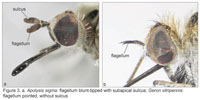
| 5. |
Cell r5 closed before wing margin (Figure 61a-m). Medium sized (5-13 mm) flies with short antennae and very long proboscis, body covered with white, yellow, orange, or brown pile |
6 |
| - |
Cell r5 open to wing margin (Figure 61n). Variable size and colour |
8 |
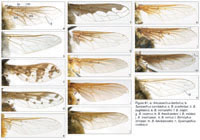
| 6. |
Crossvein r‑m situated beyond basal quarter of cell dm, cell br longer than cell bm (Figure 61c-m) |
Bombylius |
| |
7 Ontario species, 4 additional species. |
|
| - |
Crossvein r‑m situated before basal quarter of cell dm, cells br and bm of equal length (Figure 61a,b) |
7 |

| 7. |
Face rounded in side view, with dense pile (Figure 4a) |
Anastoechus |
| |
1 Ontario species, A. barbatus. 6-12 mm. Recorded in Ontario from Sault Ste. Marie and Kenora (widespread, from the Yukon south through most of U.S. except southeastern states). Larvae probably feed on grasshopper egg pods. Adults probably fly July-Aug. |
|
| - |
Face triangular in side view, with sparse pile (Figure 4b) |
Systoechus |
| |
2 Ontario species. |
|
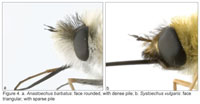
| 8. |
Medium to large (6-15 mm) flies with black tegument (Figure 5a,b); antennal flagellum entire (Figure 6a); mid- and hind tibia with rows of large bristles |
9 |
| - |
Small (1.5-6 mm) flies with yellowish or greyish tegument (Figure 5c,d); antennal flagellum with an apical sulcus containing a style (Figure 6b); mid- and hind tibia with bristles other than apical bristles tiny or absent |
10 |
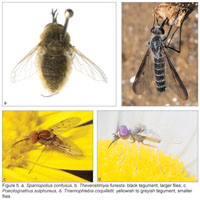 
| 9. |
Abdomen broad and flattened, covered with dense yellow pile and tomentum (Figure 5a); wing clear (Figure 62a) |
Sparnopolius |
| |
1 Ontario species, S. confusus. 6-9 mm. South of Canadian Shield (widespread from southeastern Canada, through eastern, central, southwestern and southeastern U.S. into Mexico south to neotropical Oaxaca). Larvae recorded as parasitoids on the scarab genus Phyllophaga (June beetles). Adults fly late July – Sept. |
|
| - |
Abdomen cylindrical, with sparse white and black tomentum and pile (Figure 5b); wing smoky brown along leading edge (Figure 62b,c) |
Thevenetimyia |
| |
2 Ontario species. |
|
 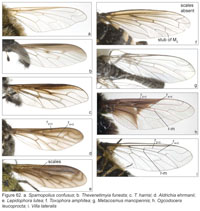
| 10. |
Yellow species with orange to reddish markings on thorax (Figure 5c); crossveins and surrounding wing membrane dark (Figure 60a) |
Poecilognathus |
| |
1 Ontario species, P. sulphureus. 4-6 mm. Rarely collected in south-central Ontario (widespread from southeastern Canada through the U.S. into northern Mexico; also known from the Bahamas and Cuba). Host unknown. Adults fly late Aug. – mid Sept. |
|
| - |
Grey species with whitish pollinosity (powdery appearance) (Figure 5d), wings slightly milky with pale veins (Figure 60b) |
Tmemophlebia |
| |
2 Ontario species. |
|
 
| 11. |
Antennae longer than head length, covered in dense scales or long pile (Figure 7a) |
12 |
| - |
Antennae shorter than head length, basal segments with short pile or bare (Figure 7b) |
14 |

| 12. |
Basal antennal segment swollen, covered with long pile (Figure 8a).Wings smoky, without scales, R2+3 arising from R4+5 at a right angle (Figure 62d). Body not hump-backed, prothorax not strongly developed (Figure 9a) |
Aldrichia |
| |
1 Ontario species, A. ehrmanii. 8-9 mm. Rarely collected, known in Ontario only from near London (also central and eastern U.S.). Host unknown. Adults recorded in May and June. |
|
| - |
Antenna covered in with long flattened scales, basal segment narrow, straight-sided (Figure 8b). R2+3 arising from R4+5 at an acute angle, wings either smoky with scales (Figure 62e) or smoky to clear without scales (Figure 62f). Strongly hump-backed, with prominent prothorax (Figure 9b) |
13 |


|
|
| 13. |
Relatively large (10-19 mm), with long, cylindrical abdomen (Figure 10a); wing dark smoky brown, with scales on dorsal surface, M2 complete (Figure 62e) |
Lepidophora |
| |
1 Ontario species, L. lutea. Central Ontario, north to Sault Ste. Marie (also eastern U.S. south to Florida). Larvae feed on provisions in nests of aculeate Hymenoptera. Adults fly late July – Sept. |
|
| - |
Smaller flies (7-8mm), with short, tapered abdomen (Figure 10b); wing pale smoky brown, without scales, M2 incomplete (Figure 62f) |
Toxophora |
| |
1 Ontario species, T. amphitea. Rare in Ontario, known from Windsor and Walpole Is. (also in a few localities in the Appalachian states south to northern Mexico). Probably a parasitoid of solitary Hymenoptera. Adults fly mid June – Sept. |
|
 
| 14. |
Hind margin of eye straight, not indented (Figure 11a); small (3-6 mm) blackish flies with sparse pile and hemispherical heads, resembling pipunculids |
Metacosmus |
| |
1 Ontario species, M. mancipennis. Rarely collected in southern Ontario (also known from Massachusetts, New Jersey and Pennsylvania). Host unknown. Adults recorded in July and August. |
|
| - |
Hind margin of eye strongly indented (Figure 11b); usually with dense pile or tomentum |
15 |

| 15. |
Broad-bodied flies with conspicuous white pile on face and end of abdomen, remainder of body with jet black pile (Figure 12). Vein R2+3 arising from R4+5 at an acute angle proximal to crossvein r‑m (Figure 28C Figure 62h) |
Ogcodocera |
| |
1 possible Ontario species, O. leucoprocta. 6-7 mm. Not collected in Ontario but known from adjacent parts of Quebec and the United States (eastern Canada south through central and southeastern U.S. to southern Mexico). Host unknown. |
|
| - |
Shape and colour variable, but not with conspicuous white pile on both face and end of abdomen. Vein R2+3 arising from R4+5 at a right angle near crossvein r‑m (Figure 62i) |
16 |
 
| 16. |
Antenna with two flagellomeres and a terminal tuft of hair (Figure 13a). Basicosta broad and projecting (Figure 14a), laterotergite and mediotergite (area between wing and halter) bare (Figure 14a) |
17 |
| - |
Antenna with one or two antennal flagellomeres and an apical stylus but without a terminal tuft of hair (Figure 13b). Basicosta sharply pointed and narrow (Figure 14b), laterotergite and mediotergite with pile (Figure 14b) |
18 |
 
| 17. |
Wing with a closed cell posterior to cell dm, formed by a secondary crossvein between crossvein m and CuA1 (Figure 63i); large flies (16-18 mm) |
Xenox |
| |
1 Ontario species, X. tigrinus. Southwestern Ontario, north to Guelph (widespread southeastern Canada and eastern and southeastern U.S.). Larvae are parasitoids of Xylocopa virginica (large carpenter bees). Adults fly Aug. – Oct. |
|
| - |
No closed cell posterior to cell dm (Figure 63a-h); small to medium flies (4-12 mm) |
Anthrax |
| |
8 Ontario species. |
|
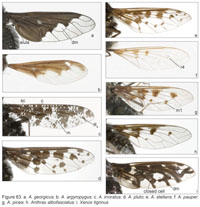
| 18. |
Veins R2+3 and R4 connected by a crossvein (Figure 64a-e) |
19 |
| - |
Veins R2+3 and R4 not connected by a crossvein (Figure 64f-n) |
20 |
| |
Some rare individuals have aberrant wing venation that could cause confusion. See alternative couplets 18b-19b below for additional characters only visible with high magnification. |
|

| 19. |
Vein R2+3 with a single curve near the apex (Figure 64a-d). Antenna with a basal conical flagellomere and an elongated second flagellomere ending in an apical stylus (Figure 15a) |
Exoprosopa |
| |
4 Ontario species. |
|
| - |
Vein R2+3 S-shaped near apex (Figure 64e). Antenna with one conical flagellomere ending in an apical stylus (Figure 15b) |
Dipalta |
| |
1 Ontario species, D. banksi. 8-11 mm. Known in Ontario from sandy areas along lakes Erie and Huron, occasionally inland (also known from Ohio and Virginia in the U.S.). Larvae parasitoids on Myrmeleontidae (antlions). Adults fly July – Sept. |
|
 
|
Alternative couplets 18b-19b. The following provide an alternative to couplets 18-19 above. |
|
| 18b. |
Antenna with one conical flagellomere ending in an apical stylus (Figure 15b); pulvilli (tarsal pads) rounded and not appearing as teeth as the base of tarsal claws |
19b |
| - |
Antenna with a basal conical flagellomere and an elongated second flagellomere ending in an apical stylus (Figure 15a); pulvilli pointed, appearing as teeth at the base of the tarsal claws |
Exoprosopa |
| 19b. |
Vein R2+3 S-shaped near apex, connected to R4 with a crossvein; wings clear with large coalesced dark spots (Figure 64e) |
Dipalta |
| - |
Vein R2+3 with a single curve near apex, not connected to R4 (Figure 64f-n); wings not spotted, or wings dark with clear spots |
20 |

| 21. |
Anterior half of wings dark brown, sharply divided from clear posterior half (Figure 65a-e) |
Hemipenthes |
| |
4 Ontario species. |
|
| - |
Wings usually clear (Figure 65f), anterior edge occasionally smoky brownish as far as crossvein r‑m, but dark portion not sharply divided from clear posterior part (Figure 65g-j) |
Villa |
| |
12 recorded Ontario species, 4 additional species. |
|
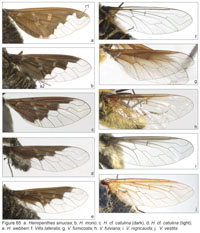
| 22. |
Face with only thin, mostly erect hairs (Figure 17a); wings extensively smoky brown with or without clear spots (Figure 64f-i); basal antennal segment strongly expanded at apex in dorsal view, wider than 2nd segment (Figure 18a) |
Poecilanthrax |
| |
3 recorded Ontario species, 1 additional species. |
|
| - |
Face with some flattened scale-like hairs (Figure 17b); apical third or more of wings clear (Figure 64j-n); basal antennal segment not strongly expanded at apex (Figure 18b) |
23 |
 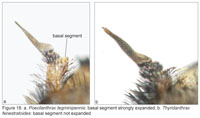 
| 23. |
Fore tibia with bristles about as long as diameter of the tibia; claws on each leg equal in size (Figure 19a); basal half of wing dark brown (Figure 64j); abdomen black with yellow and black bands of tomentum (Figure 20a) |
Paravilla
|
| |
1 Ontario species, P. separata. 9-12 mm. Known in Ontario from Lambton Co. and St. Joseph I. (southern Canada, south through central and southeastern U.S.). Larvae are probably parasitoids of solitary bees. Adults fly late July – early Sept. |
|
| - |
Fore tibia without long bristles, at most very short hairs present; claws on fore tibia smaller than claws of other legs (Figure 19b); wing pattern variable, if basal half of wing dark brown without clear spots then sides of abdomen orange and body covered with orange tomentum (Figure 20b) |
24 |
 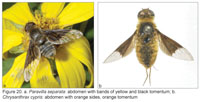 
| 24. |
Basal half of wing dark brown with clear windows around crossveins (Figure 64k); pale bands on abdomen interrupted in middle by black tomentum (Figure 21a) |
Thyridanthrax |
| |
1 Ontario species, T. fenestratoides. 13 mm. Known in Ontario from north and west of Lake Superior (southern Canada, south through central U.S. to north central Mexico). Host unknown, hosts of the genus include Hymenoptera, Coleoptera, Lepidoptera, and Orthoptera. Adults fly late June – early July. |
|
| - |
Wing pattern variable, either pale smoky brown with dark crossveins (Figure 64l) or dark brown basally, but without clear windows (Figure 64m,n); abdomen covered in yellow to orange tomentum (Figure 21c,d) or dark with complete pale bands (Figure 21b) |
Chrysanthrax |
| |
1 recorded Ontario species, 2 additional species. |
|
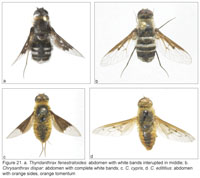 
| Introduction | Checklist | Key to genera | Species keys | Gallery | References | PDF 41.7 MB | Cite this Article | Updates |
|
|




























